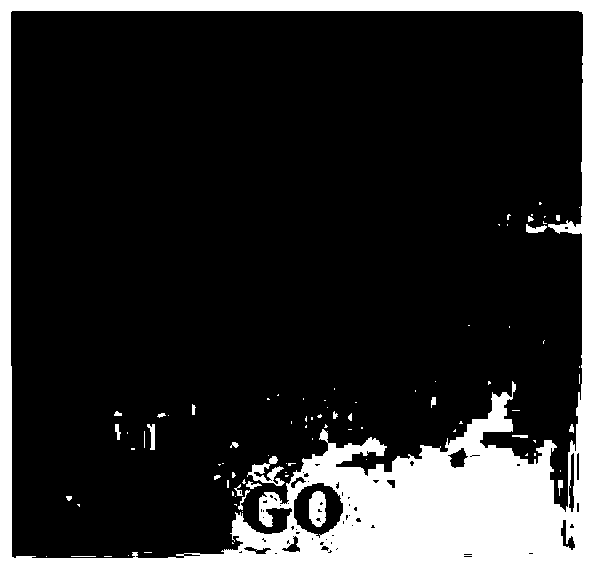Nano-composite proton exchange membrane as well as preparation method and application thereof
A proton exchange membrane and nanocomposite technology, applied in the field of proton exchange membrane fuel cells, can solve the problems of acid-base composite materials to be explored, and achieve the effect of excellent battery performance
- Summary
- Abstract
- Description
- Claims
- Application Information
AI Technical Summary
Problems solved by technology
Method used
Image
Examples
Embodiment 1
[0038] 4.5 g graphite flakes and 27.0 g KMnO 4 Slowly added to 600 mL of mixed acid (540 mL of concentrated sulfuric acid and 60 mL of phosphoric acid) under vigorous stirring. The reaction solution was heated to 50 °C and stirred for 20 h, then the resulting solution was cooled and poured into 1200 mL of water and 30 mL of H 2 o 2 in the mixture. After ultrasonic treatment for 1 h, centrifuge at 800 rpm for 5 min, and centrifuge the obtained supernatant at 10,000 rpm, suspend the obtained solid in 30 wt% HCL aqueous solution, and disperse the obtained powder in 300 mL of 10 wt% HCL after the supernatant is centrifuged Stirring in medium temperature for 12 h, centrifugation, CH 3 OH was washed, vacuum dried and ground to obtain GO.
[0039]Add 5.0 g GO to 100 mL 2.0 mg mL -1 Dopamine aqueous solution (pH 8.5), stirred at room temperature for 4 h, centrifuged, washed with deionized water, and dried at 60 °C to obtain DGO.
[0040] 0.01875 g DGO was added to 6.0 g DMF, son...
Embodiment 2
[0043] 4.5 g graphite flakes and 27.0 g KMnO 4 Slowly added to 600 mL of mixed acid (540 mL of concentrated sulfuric acid and 60 mL of phosphoric acid) under vigorous stirring. The reaction solution was heated to 50 °C and stirred for 20 h, then the resulting solution was cooled and poured into 1200 mL of water and 30 mL of H 2 o 2 in the mixture. After ultrasonic treatment for 1 h, centrifuge at 800 rpm for 5 min, and centrifuge the obtained supernatant at 10,000 rpm, suspend the obtained solid in 30% HCL aqueous solution, and disperse the obtained powder in 300 mL of 10% HCL after the supernatant is centrifuged Stirring in medium temperature for 12 h, centrifugation, CH 3 OH was washed, vacuum dried and ground to obtain GO.
[0044] Add 5.0 g GO to 100 mL 2.0 mg mL -1 Dopamine aqueous solution (pH 8.5), stirred at room temperature for 4 h, centrifuged, washed with deionized water, and dried at 60 °C to obtain DGO.
[0045] 0.0375 g DGO was added to 7.5 g DMF, sonicated...
Embodiment 3
[0048] 4.5 g graphite flakes and 27.0 g KMnO 4 Slowly added to 600 mL of mixed acid (540 mL of concentrated sulfuric acid and 60 mL of phosphoric acid) under vigorous stirring. The reaction solution was heated to 50 °C and stirred for 20 h, then the resulting solution was cooled and poured into 1200 mL of water and 30 mL of H 2 o 2 in the mixture. After ultrasonic treatment for 1 h, centrifuge at 800 rpm for 5 min, and centrifuge the obtained supernatant at 10,000 rpm, suspend the obtained solid in 30% HCL aqueous solution, and disperse the obtained powder in 300 mL of 10% HCL after the supernatant is centrifuged Stirring in medium temperature for 12 h, centrifugation, CH 3 OH was washed, vacuum dried and ground to obtain GO.
[0049] Add 5.0 g GO to 100 mL 2.0 mg mL -1 Dopamine aqueous solution (pH 8.5), stirred at room temperature for 4 h, centrifuged, washed with deionized water, and dried at 60 °C to obtain DGO.
[0050] 0.05625 g DGO was added to 7.5 g DMF, sonicate...
PUM
| Property | Measurement | Unit |
|---|---|---|
| Young's modulus | aaaaa | aaaaa |
| Tensile strength | aaaaa | aaaaa |
| Proton conductivity | aaaaa | aaaaa |
Abstract
Description
Claims
Application Information
 Login to View More
Login to View More - R&D
- Intellectual Property
- Life Sciences
- Materials
- Tech Scout
- Unparalleled Data Quality
- Higher Quality Content
- 60% Fewer Hallucinations
Browse by: Latest US Patents, China's latest patents, Technical Efficacy Thesaurus, Application Domain, Technology Topic, Popular Technical Reports.
© 2025 PatSnap. All rights reserved.Legal|Privacy policy|Modern Slavery Act Transparency Statement|Sitemap|About US| Contact US: help@patsnap.com



